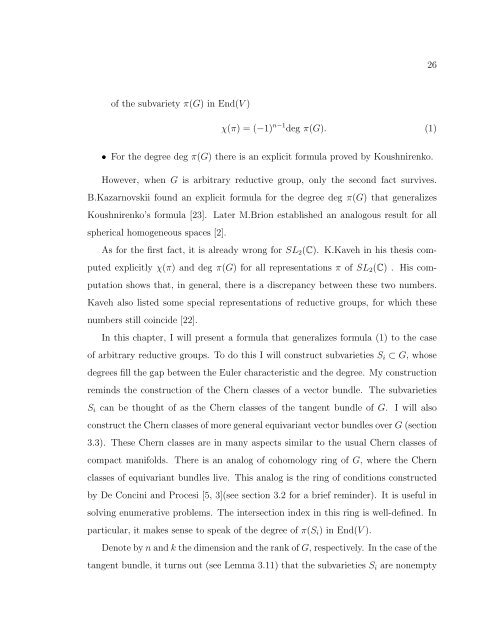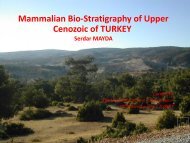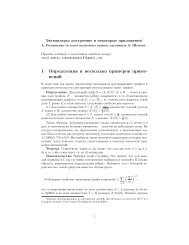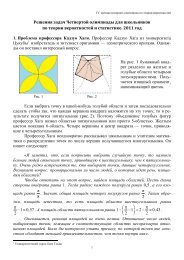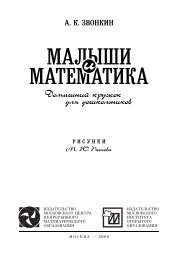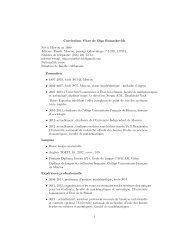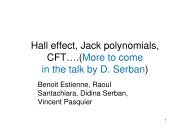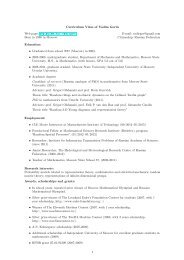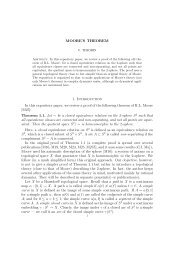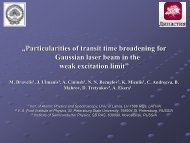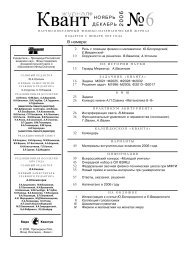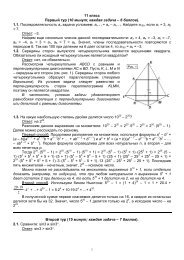a gauss-bonnet theorem, chern classes and an adjunction formula
a gauss-bonnet theorem, chern classes and an adjunction formula
a gauss-bonnet theorem, chern classes and an adjunction formula
You also want an ePaper? Increase the reach of your titles
YUMPU automatically turns print PDFs into web optimized ePapers that Google loves.
26<br />
of the subvariety π(G) in End(V )<br />
χ(π) = (−1) n−1 deg π(G). (1)<br />
• For the degree deg π(G) there is <strong>an</strong> explicit <strong>formula</strong> proved by Koushnirenko.<br />
However, when G is arbitrary reductive group, only the second fact survives.<br />
B.Kazarnovskii found <strong>an</strong> explicit <strong>formula</strong> for the degree deg π(G) that generalizes<br />
Koushnirenko’s <strong>formula</strong> [23]. Later M.Brion established <strong>an</strong> <strong>an</strong>alogous result for all<br />
spherical homogeneous spaces [2].<br />
As for the first fact, it is already wrong for SL 2 (C). K.Kaveh in his thesis computed<br />
explicitly χ(π) <strong><strong>an</strong>d</strong> deg π(G) for all representations π of SL 2 (C) . His computation<br />
shows that, in general, there is a discrep<strong>an</strong>cy between these two numbers.<br />
Kaveh also listed some special representations of reductive groups, for which these<br />
numbers still coincide [22].<br />
In this chapter, I will present a <strong>formula</strong> that generalizes <strong>formula</strong> (1) to the case<br />
of arbitrary reductive groups. To do this I will construct subvarieties S i ⊂ G, whose<br />
degrees fill the gap between the Euler characteristic <strong><strong>an</strong>d</strong> the degree. My construction<br />
reminds the construction of the Chern <strong>classes</strong> of a vector bundle. The subvarieties<br />
S i c<strong>an</strong> be thought of as the Chern <strong>classes</strong> of the t<strong>an</strong>gent bundle of G. I will also<br />
construct the Chern <strong>classes</strong> of more general equivari<strong>an</strong>t vector bundles over G (section<br />
3.3). These Chern <strong>classes</strong> are in m<strong>an</strong>y aspects similar to the usual Chern <strong>classes</strong> of<br />
compact m<strong>an</strong>ifolds. There is <strong>an</strong> <strong>an</strong>alog of cohomology ring of G, where the Chern<br />
<strong>classes</strong> of equivari<strong>an</strong>t bundles live. This <strong>an</strong>alog is the ring of conditions constructed<br />
by De Concini <strong><strong>an</strong>d</strong> Procesi [5, 3](see section 3.2 for a brief reminder). It is useful in<br />
solving enumerative problems. The intersection index in this ring is well-defined. In<br />
particular, it makes sense to speak of the degree of π(S i ) in End(V ).<br />
Denote by n <strong><strong>an</strong>d</strong> k the dimension <strong><strong>an</strong>d</strong> the r<strong>an</strong>k of G, respectively. In the case of the<br />
t<strong>an</strong>gent bundle, it turns out (see Lemma 3.11) that the subvarieties S i are nonempty


